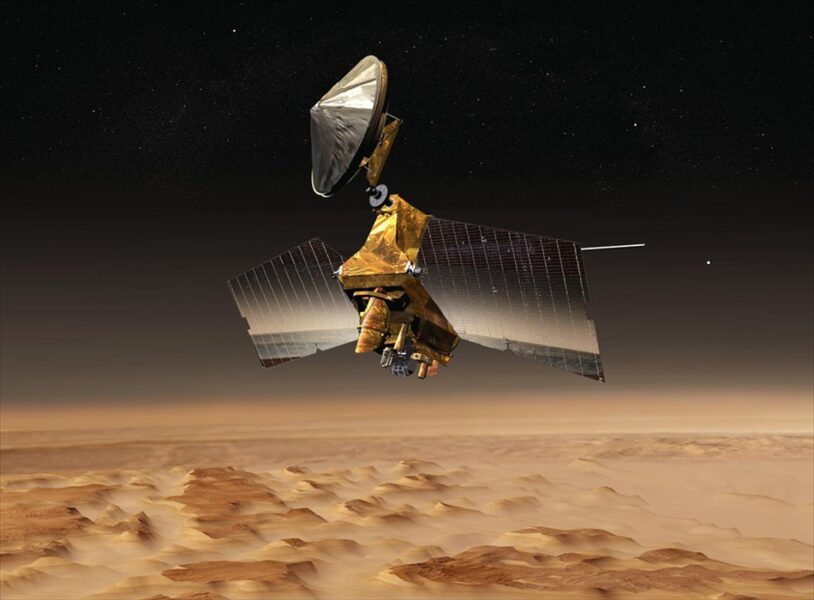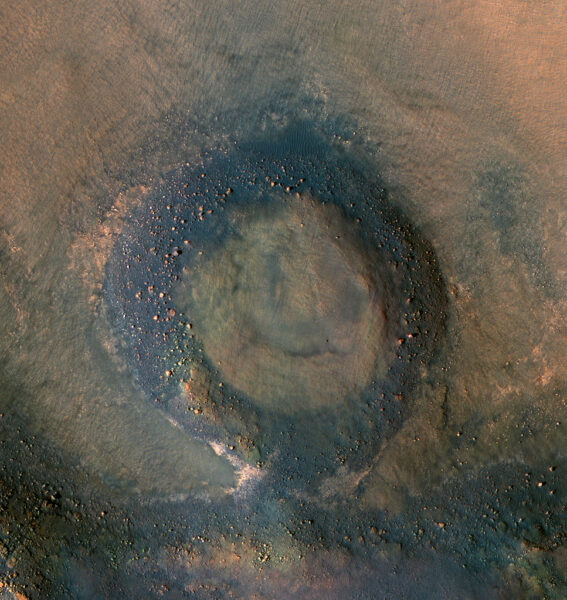A geologically recent landslide on Mars appears like mudslides on Earth — but it would have required water during a time when Mars was expected to be dry.

NASA / JPL-Caltech
Approximately 5 million years ago, a portion of the western wall of a large and deep impact crater located in the Nilosyrtis Mensae region of Mars gave way. The Red Planet’s landscape abounds with steep canyon walls that have collapsed, so landslides must be quite common. But what makes this one particularly interesting is that it shows traits of being a mudslide.
In a new study published in the October 15th Planetary and Space Science journal, researchers used high-resolution imagery to construct a digital elevation model of the landslide. Then they compared its shape and form to actual landslides on Mars and Earth, and to a computer-generated landslide, and found signs that water could have been involved at a time when Mars was expected to be dry.

NASA / JPL / Univ. of Arizona
The Landslide
The Nilosyrtis Mensae landslide is big by Earth-standards (it carried approximately 200,000 dump trucks’ worth of material), but smaller than most Martian landslides that have been studied. The slide happened on a 25-degree slope and travelled a distance of about six football fields, resulting in a deposit area that had a maximum thickness of about 30 meters and covered the equivalent of about 10 average-sized city blocks.
The characteristics of the Nilosyrtis Mensae landslide were similar to those of a mudslide near the town of Hόlmavίk, Iceland and another near Mount Rainer in Washington state which suggests that water saturated the regolith and caused the loss of cohesion, says Anthony Guimpier, lead-author of the study (University of Nantes, France).
In particular, Guimpier and colleagues found that the Nilosyrtis Mensae landslide formed along a gradual slope, formed well-defined margins that separated the deposit area from the surrounding region, and transported relatively few and small boulders — all features that suggest water was involved. The two rockslides on Mars had contrasting features and the researchers suggest that these may have been caused by meteorite impacts or marsquakes.

Guimpier et al. / Europlanet Science Congress
Clay and Water
Clay-size grains and liquid water are key requirements of a mudslide. Surveys of the Nilosyrtis Mensae region show clay minerals that formed early in Martian history, when liquid water existed on the planet’s surface. But scientists do not expect that liquid water was present at the time of the mudslide.
“It’s difficult to imagine liquid water in the near-surface in sufficient quantities to cause a mudslide at the scale of the Nilosyrtis Mensae landslide,” says Janice Bishop (SETI Institute), who was not involved in the study. “But we don’t understand the geothermal heat flow well enough yet.”
Guimpier and colleagues suggest that underground heat, which warmed the Nilosyrtis Mensae region billions of years ago, might still be present. “Perhaps some remnants of this geothermal heat melted ice that could have been in the ground, causing the mudslide,” says Guimpier.
Mars currently spins on an axis tilted about 25º to the plane of the solar system, similar to Earth’s tilt. But unlike Earth, Mars’s tilt has varied widely, and it was thought to have been higher around the time of the landslide. The higher tilt could have enabled the presence of ice closer to the equator, says Guimpier.
Recurring Slope Lineae
The possibility of melting ice below the surface has been examined for a type of surface movement known as recurring slope lineae (RSL) — seasonal dark flow lines that appear on the surface of present-day Mars.
In a recent study, Bishop and her colleagues found that salty ice below the Martian surface could be slowly melting and destabilizing the surface, contributing to RSL. Others have disputed the connection to groundwater.
Like Guimpier and his team, Bishop and her team looked at terrestrial analogues to better understand what happened — and is happening — on Mars. Orbiters also continue to survey the regions and could provide further insight on the Nilosyrtis Menae landslide and the RSL. But sampling the sites directly on the Martian surface would be ideal.
“These are interesting sites for future rovers to study the mineralogy of the surface materials, to examine if water was involved,” says Bishop.
 0
0









Comments
You must be logged in to post a comment.